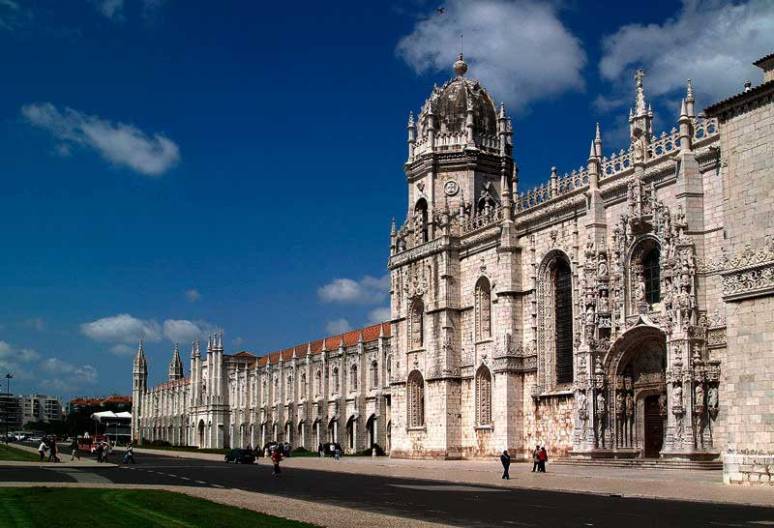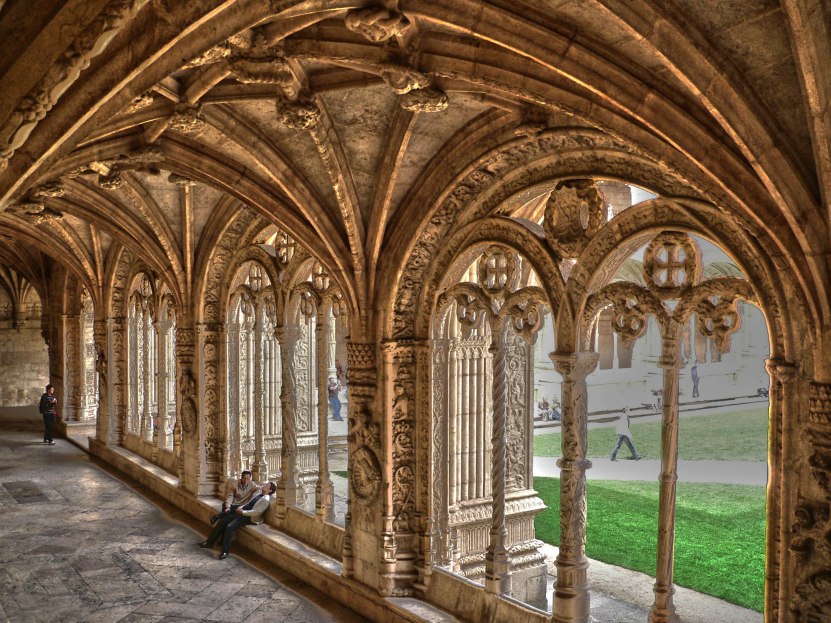Jeronimos Monastery, the jewel of Belem in Lisbon

Una de las visitas imprescindibles en tu viaje a Lisboa ha de ser, ….
A must visit on your trip to Lisbon being undoubtedly ….
Una de las visitas imprescindibles en tu viaje a Lisboa ha de ser, sin duda, el Monasterio de los Jerónimos, monumento de principios del siglo XVI y máximo exponente de la denominada arquitectura manuelina.
Para visitar el Monasterio de los Jerónimos has de ir al barrio de Belem, siguiendo el curso del río Tajo al oeste de Lisboa, donde llegarás tras pasar bajo el gran Puente 25 de Abril.
Si no dispones de coche, lo mejor es coger el tranvía 15 que sale de la Plaza de Comercio. Tardarás algo menos de media hora en llegar al monasterio.
El gigantesco monasterio forma también parte del Patrimonio de la Humanidad, junto con la Torre de Belém. Con ella comparte el estilo arquitectónico y la época de construcción (las obras comenzaron en 1501) en pleno apogeo de los “Descubrimientos”. El Rey Manuel I lo mandó construir para celebrar el feliz regreso de Vasco de Gama desde la India. Se levantó pues, como símbolo del expansionismo portugués y se utilizó para despedir y saludar a los navegantes en sus largos viajes. El monasterio fue confiado a la Orden de San Jerónimo y sus monjes permanecieron en él hasta 1833, año en que fueron expulsados y el complejo fue secularizado.
La fachada del impresionante conjunto se extiende más de 300 metros. La puerta principal se encuentra al oeste. Sobre ella hay escenas del nacimiento de Cristo, a la izquierda esculturas del rey Manuel I y San Jerónimo y a la derecha, de su segunda esposa, la reina María, y San Juan Bautista. Por ella se accede a la nave de la Iglesia de Santa María de Belém.
A must visit on your trip to Lisbon being undoubtedly the Jeronimos Monastery, monument of the early sixteenth century exponent of the so-called Manueline architecture.
To visit the Monastery of Jeronimos have to go to the district of Belem, following the course of the Tagus River west of Lisbon where you arrive after passing under the big bridge on April 25.
If you do not have a car, it is best to take the tram 15 which leaves the Square Trade. It takes just under half an hour to reach the monastery.
The huge monastery is also part of World Heritage, along with the Torre de Belém. She shares with the architectural style and period of construction (construction began in 1501) at the height of the «Discovery». King Manuel I had it built to celebrate the safe return of Vasco de Gama from India. He then rose as a symbol of Portuguese expansionism and used to dismiss and greet the sailors on their long journeys. The monastery was entrusted to the Order of St. Jerome and his monks remained there until 1833, when they were expelled and the complex was secularized.
The facade of the impressive range stretches over 300 meters. The main entrance is to the west. On it there are scenes of the birth of Christ, to the left sculptures of King Manuel I and Jerome and right, his second wife, Queen Mary and San Juan Bautista. Through it you access the ship of the Church of Santa Maria de Belém.
La iglesia de Santa María de Belem, se empezó a construir en 1514, pero se han realizado remodelaciones hasta casi el siglo XX. Es un edificio de clara configuración gótica, con una planta de cruz latina y una gran nave central dividida en tres partes de similar altura, con altas columnas y unos techos decorados con profusas nervaduras.
The church of Santa Maria de Belem, was begun in 1514, but renovations have been made to almost the twentieth century. It is a building of Gothic architecture clear, with a Latin cross and a large central nave divided into three parts of similar height, with tall columns and a ceiling decorated with profuse ribs.
Sin embargo, será frente a dos grandes sepulcros donde más te vas a detener. Según entras en la iglesia, a la derecha tienes la tumba de Luis de Camoens, y en el lado opuesto puedes ver la tumba de Vasco de Gama.
However, it will face two more graves where you’re going to stop. As you enter the church, on the right you have the tomb of Luis de Camoes, and on the opposite side you can see the tomb of Vasco da Gama.
El claustro es la parte más impresionante del monasterio. No creo haber visto nunca un claustro de tal magnitud y belleza. Para visitarlo hay que pagar 6 euros, pero vale la pena, es una maravilla.
Consta de dos pisos y está ampliamente decorado con motivos manuelinos (letra M, esfera armilar, cabos marineros, temas religiosos, hornacinas, medallones, etc.)
The cloister is the most impressive part of the monastery. I do not think I’ve ever seen a cloister of such magnitude and beauty. To visit you must pay 6 euros, but worth it, it’s wonderful.
It has two floors and is widely decorated with Manueline motifs (letter M, armillary sphere, ropes sailors, religious themes, niches, medallions, etc.)
Otra de las partes importantes de este conjunto monumental es el Refectorio, cubierto por una colosal bóveda nervada. Sus paredes están decoradas con la línea de una soga y con azulejos del siglo XVIII.
Another important part of this monumental complex is the refectory, covered by a colossal ribbed vault. Its walls are decorated with a rope line and eighteenth century tiles.




















La belleza está en todas partes.La arquitectura es rica y hermosa.Una verdadera obra maestra!
Es impresionante, sí. Por esa razón decidí dedicarle un post en exclusiva. Un abrazo!
spectacular photos! I love the colours and details, these are amazing Jacint 🙂
Thanks my friend! So glad you like it!
Maravilloso reportaje que me trae unos estupendos recuerdos. Excepcional lugar. Gracias, Jacinto.
Feliz día de Reyes.
Un abrazo.
Espero te hayas portado muy bien y no te dejen carbón! Felices Reyes para tí tambien, Isabel! una abraçada!
Impresionante….. Fotografia y historia! Mis complimentos!
Thanks for stopping by my blog and your comment! 🙂
Amazing – I can see why you recommend it. Spectacular architecture!
It is impressive, yes. For that reason I decided to devote a post exclusively.A marvel. Saludos my friend! 🙂